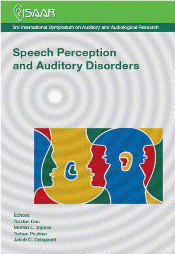Auditory steady state responses in cochlear implants
Abstract
Electrically Auditory Steady State Responses (EASSRs) are EEG potentials in response to periodic electrical stimuli presented through a cochlear implant (CI). Recently, for slow rate pulse trains in the 40Hz range, the electrophysiological thresholds derived from response amplitude growth functions have been demonstrated to correlate well with behavioral thresholds at these rates. In the following studies we show that auditory steady state potentials can as well be reliably evoked by amplitude- modulated or pulse-width-modulated high-rate pulse trains at clinically used carrier rates, and that stimulus artifacts can be completely removed from the electrophysiological recordings. Multichannel EEG-data have been recorded in Nucleus cochlear implant users. The properties of the resulting responses with regards to amplitude, phase and apparent latency are analyzed. The predictive value of electrophysiological thresholds derived from such responses for behavioral thresholds at these high rates is examined. This objective threshold determination method may be used in future CI fitting paradigms.
References
Galambos, R., Makeig, S., and Talmachoff, P. J. (1981). “A 40-Hz auditory potential recorded from the human scalp” Proceedings of the National Academy of Sciences of the United States of America, 78 (4), 2643-7
Hofmann, M., and Wouters, J. (2010). “Electrically evoked auditory steady state responses in cochlear implant users” Journal of the Association of Research in Otolaryngology, 11 (2), 267-282
Hofmann, M., and Wouters, J. (2011). “Improved detection of auditory steady state responses with electrical stimuli in cochlear implant users” Submitted
Jeng, F.-C., Abbas, P. J., Brown, C. J., Miller, C. A., Nourski, K. V., and Robinson, B. K. (2007) “Electrically evoked auditory steady-state responses in guinea pigs” Audiology and Neuro-Otology, 12 (2), 101-12
Jeng, F.-C., Abbas, P. J., Brown, C. J., Miller, C. A., Nourski, K. V., and Robinson, B. K. (2008) “Electrically evoked auditory steady-state responses in a guinea pig model” Audiology and Neuro-Otology, 13 (3), 161-71
Luts, H., Desloovere, C., and Wouters, J. (2006). “Clinical application of dichotic multiple-stimulus auditory stead-state responses in high-risk newborns and young children” Audiology and Neuro-Otology, 11, 1, 24-37
McKay, C. M., Fewster, L., and Dawson, P. (2005), “A different approach to using neural response telemetry for automated cochlear implant processor programming” Ear and Hearing, 26 (4 Suppl), 38S-44S
Ménard, M., Gallégo, S., Truy, E., Berger-Vachon, C., Durrant, J. D., and Collet, L. (2004), “Auditory steady-state response evaluation of auditory thresholds in cochlear implant patients” International Journal of Audiology 43, 39-43
Miller, C. A., Brown, C. J., Abbas, P. J., and Chi, S. L. (2008), “The clinical application of potentials evoked from the peripheral auditory system” Hearing Research 242 (1-2), 184-97
Picton, T. W., John, M. S., Dimitrijevic, A., and Purcell, D. W. (2003). “Human auditory steady state responses” International Journal of Audiology 42 (2), 177- 219
Picton, T.W. (2011). Human auditory evoked potentials, Plural Publishing, San Diego
Poelmans, H., Luts, H., Vandermosten, M., Boets, B., Ghesquière, P., and Wouters, J. ( 2011). “Auditory steady-state cortical responses indicate deviant phonemic- rate processing in adults with dyslexia” Ear and Hearing, in press
Additional Files
Published
How to Cite
Issue
Section
License
Authors who publish with this journal agree to the following terms:
a. Authors retain copyright* and grant the journal right of first publication with the work simultaneously licensed under a Creative Commons Attribution License that allows others to share the work with an acknowledgement of the work's authorship and initial publication in this journal.
b. Authors are able to enter into separate, additional contractual arrangements for the non-exclusive distribution of the journal's published version of the work (e.g., post it to an institutional repository or publish it in a book), with an acknowledgement of its initial publication in this journal.
c. Authors are permitted and encouraged to post their work online (e.g., in institutional repositories or on their website) prior to and during the submission process, as it can lead to productive exchanges, as well as earlier and greater citation of published work (See The Effect of Open Access).
*From the 2017 issue onward. The Danavox Jubilee Foundation owns the copyright of all articles published in the 1969-2015 issues. However, authors are still allowed to share the work with an acknowledgement of the work's authorship and initial publication in this journal.


